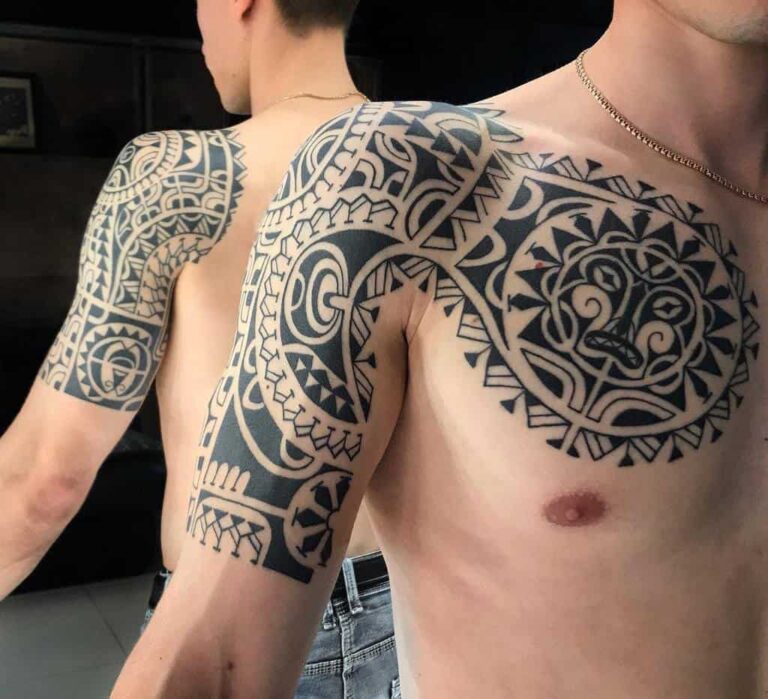The Maori style tattoo has faithful lovers, and every day it finds new followers. The attraction of this style of design is that, besides its beautiful graphics, there is a broad symbolism behind each artwork that reflects aspects of a people with a unique culture.
Maori is more than a tattoo style per se. It is a demonstration of strength, struggle, courage, and culture of this native people of New Zealand.

Maori and its history
Maoriis what the original indigenous inhabitants of New Zealand are called, called by them as Aotearoa or ?the land of the long white clouds?
According to Abel Tasman, Dutch navigator, explorer and trader, the Maori have only legends and oral traditions to explain their presence in New Zealand by their customs, such as MOKO. Native tradition tells that the first settlers used to mark their faces for battle with charcoal, and that this is how the first tattoos were made. All men, whether they were warriors or of high social standing, were obligatorily tattooed on the face and also on other parts of the body. Except slaves and the native population in general.
The term ?tattoo? is not known in New Zealand. The name given to ?decorative marks? is MOKO.
The first navigations and stories about New Zealand and its customs are credited to Abel Tasman (1642) and Captain CookThe latter was responsible for the most detailed description of the moko. Also according to Captain Cook, during his trip, he observed that each tribe seemed to have a different custom regarding tattooing. Their bodies and faces were marked with black spots, called ?Amoco? ? large spirals on each buttock. The thighs of many were almost entirely black, the faces of the older men almost entirely covered.
In free translation, an account by Captain James Cook, one of the people responsible for the colonization of that territory, regarding the Maori tattoo:
The marks, in general, are spirals drawn with great finesse and even elegance. The sides correspond to each other. The marks on the body resemble foliage on old ornaments, [?] but in these works there is such luxury in the forms that, out of hundreds of drawings apparently alike at first sight, a close examination makes it clear that there are no equal productions.?

The minutely drawn spirals are symmetrical, with one side corresponding to the other. However, these markings vary greatly on different parts of the coast and islands.
To John LubbockWhen it came to Polynesian tattooing, for him the most beautiful was that of the New Zealanders, because they were tattooed in spiral lines.

The process is extremely painful, especially on the lips. Once one has shrunk from it or even shown any signs of suffering while undergoing it is considered unmanly. It was a matter of honor and pride to the warriors.
Maori is much more than a tattoo for the new New Zealander. It is used as communication, a kind of hieroglyphic.
The instruments used by the Maori for the execution of mokos were pieces of human bone, tortoise shell, or metal, dipped in pigment and then beaten with a small stick.

In order to obtain scars and grooves, which identify the moko, it was necessary for the instrument to penetrate deeply into the muscle tissue, and the cuts were so deep that they sometimes pierced and went through the cheek. When they went to war, they would cut off the enemy's head and place it in sacred urns. In the 19th century, the tattooed heads of Maori warriors became coveted objects by European collectors. The trafficking of these heads began; the Maori themselves began to trade them for firearms.
The practice of moko on slaves served only to increase the number of tattooed heads in order to exchange them for firearms.
The expert tattoo artists in T? Moko are called Tohunga T? moko. Even today, tattoos still show authority and respect for those who know their meanings.
A woman who has a tattooed chin can mean that she is married or has great respect within a certain group.

In the case of men, we can see this in the government of the country, which is divided between Kiwis e Maoris. Many Maoris Those who hold high positions in government have most, if not all, of their faces tattooed. Those in lower positions have less experience, and therefore fewer tattoos.
Maori tattoo symbols
Among some Maori sacred symbols, which can be seen in crafts and also in tattoos, are:
- Tiki ? It personifies the ?man? first created. His representations are usually in human form, with a naturalistic head. Each sculpture had an identity that represented a particular ancestor or spirit. An important relationship between Tiki and man was through Tiki's "revelations or personalities," which manifested themselves through acts of "bravery," "wisdom," or "strength.
- Manaia ? The manaia is the second predominant symbol after the tiki and, according to legend, is a messenger bird between the earthly and spiritual worlds. Holder of great energy, it guards against evil and protects the land, sea, and skies.
- Geckos ? Gifted with supernatural powers, they can see into the future and protect people against dangers that may present themselves.
- Human language ? The tongue is common in tiki representations and also present in ceremonial dances, where it constitutes an act of defiance and is a symbol of courage and strength. It relates to the warrior nature of Maori.
- Koru ? The spiral, symbol of rebirth, represents the cyclical movement of life.





Comments are closed.